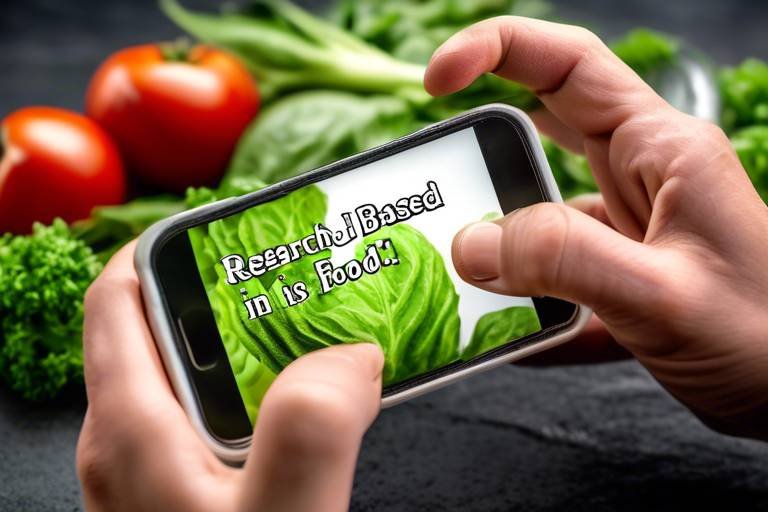The Latest Research on Plant-Based Innovations in Food
In recent years, the world has witnessed a remarkable shift towards plant-based diets, driven by a growing awareness of health, sustainability, and ethical concerns. This article explores the latest advancements in plant-based food technologies that are not only enhancing nutrition but also transforming culinary experiences. With global food challenges looming large, these innovations are paving the way for a more sustainable and nutritious future. From emerging plant-based proteins to cutting-edge fermentation techniques, the landscape of food is evolving, and it’s exciting to see how these developments can address our dietary needs while being kinder to our planet.
Recent studies have unveiled a treasure trove of new sources of plant-based proteins, including legumes, grains, and even novel crops that were previously underutilized. These proteins are not just a substitute; they are packed with nutritional benefits that can rival traditional animal proteins. For instance, quinoa and lentils are not only rich in protein but also offer essential amino acids, fiber, and micronutrients. By incorporating these ingredients into our diets, we can enhance our overall health while reducing our reliance on animal farming, which is often linked to environmental degradation.
Innovations in plant-based meat alternatives have come a long way, with products now closely mimicking the taste and texture of traditional meats. This has significantly improved consumer acceptance, expanding market potential. Companies are utilizing advanced food science to create burgers that sizzle, sausages that snap, and even chicken that pulls apart just like the real thing. Imagine biting into a juicy burger that not only tastes great but is also made entirely from plants! This is not just a dream; it’s the reality of today’s food technology.
One of the most exciting advancements is the use of 3D printing technology in food production. This innovative approach allows chefs and food scientists to create unique textures and shapes that enhance the culinary experience. Picture a beautifully crafted plant-based dish that looks like art on a plate! Not only does 3D printing offer aesthetic benefits, but it also helps reduce waste by utilizing precise amounts of ingredients.
Moreover, 3D printing enables the customization of nutritional profiles in plant-based foods. Whether you are looking for high protein, low carb, or specific vitamins and minerals, this technology can cater to your dietary needs and preferences. It’s like having a personal nutritionist at your fingertips, ensuring that every meal is tailored to promote healthier eating habits.
The sustainability impact of 3D printing in food production is profound. By minimizing food waste and resource consumption, we can contribute to more sustainable food systems. Imagine a world where every meal is not only delicious but also environmentally friendly. This is the future we are heading towards, thanks to innovative technologies that prioritize our planet's health.
Another groundbreaking innovation is the use of fermentation techniques to enhance flavors and nutritional profiles in plant-based foods. Fermentation unlocks new culinary possibilities, improving digestibility and adding complex flavors that can elevate any dish. Think of it as a magic trick that transforms humble ingredients into gourmet delights. Foods like kimchi, tempeh, and kombucha are perfect examples of how fermentation can create delicious and nutritious plant-based options.
Research continues to demonstrate the numerous health benefits associated with plant-based diets. Studies indicate that these diets can lead to reduced risks of chronic diseases, improved gut health, and enhanced overall well-being. By choosing a plant-centric approach, individuals can enjoy a variety of essential vitamins, minerals, and antioxidants that support a healthier lifestyle and longevity.
Exploring the nutritional insights of plant-based diets reveals a wealth of information. Foods like leafy greens, nuts, seeds, and whole grains are bursting with nutrients that are vital for our health. Incorporating a diverse range of these foods can help ensure that we meet our dietary needs while enjoying a vibrant and flavorful diet.
Understanding public perception and acceptance of plant-based diets is crucial for promoting these innovations. Consumer attitudes significantly influence market trends and product development, making it essential to engage with the community. As more people become aware of the benefits of plant-based eating, we can expect to see a surge in demand for innovative products that cater to these preferences.
The future of plant-based innovations is bright, with ongoing research and development focused on enhancing flavor, nutrition, and sustainability. As we continue to explore new ingredients and technologies, the landscape of food will become increasingly plant-centric. This shift not only promises a more sustainable food system but also opens up exciting culinary possibilities for everyone.
- What are the main benefits of a plant-based diet? A plant-based diet can reduce the risk of chronic diseases, improve gut health, and promote overall well-being.
- How do 3D printing technologies impact food sustainability? 3D printing minimizes food waste and allows for precise ingredient usage, contributing to more sustainable food systems.
- What role does fermentation play in plant-based foods? Fermentation enhances flavors, improves digestibility, and adds nutritional value to plant-based foods.

Emerging Plant-Based Proteins
The world of nutrition is witnessing a remarkable shift as plant-based proteins emerge as a viable alternative to traditional animal proteins. Recent studies have spotlighted a variety of sources that are not only nutritious but also environmentally sustainable. Legumes, grains, and even novel crops are stepping into the limelight, offering a treasure trove of benefits that go beyond mere protein content.
Legumes, such as lentils and chickpeas, have long been staples in many diets around the globe. They are packed with essential amino acids, making them a fantastic source of protein for those looking to reduce their meat consumption. Additionally, legumes provide significant amounts of fiber, which aids in digestion and promotes a feeling of fullness. It's like having your cake and eating it too—enjoying delicious meals while nourishing your body!
Grains, particularly quinoa and amaranth, are also gaining traction as powerful plant-based protein sources. Quinoa, often dubbed a "superfood," contains all nine essential amino acids, making it a complete protein. This is particularly advantageous for vegetarians and vegans who might struggle to get enough protein in their diets. Imagine a world where your meals are not only tasty but also contribute to your well-being—this is the promise of these emerging proteins.
Moreover, researchers are exploring novel crops like hemp and spirulina, which are rich in protein and other vital nutrients. Hemp seeds, for instance, are not just a protein powerhouse; they also contain healthy fats and minerals that can enhance overall health. Spirulina, a blue-green algae, boasts an impressive protein content and is packed with antioxidants, making it a fantastic addition to smoothies and health supplements.
These emerging plant-based proteins are not only beneficial for individual health but also play a crucial role in addressing global food challenges. The production of animal protein often leads to significant environmental degradation, including deforestation and greenhouse gas emissions. In contrast, plant-based proteins require fewer resources and have a lighter ecological footprint. This transition towards plant-based sources could be a game-changer in our fight against climate change.
In summary, the rise of is not just a trend; it's a revolution in how we think about food. By embracing these alternatives, we can enjoy a diverse range of flavors and textures while contributing to a healthier planet. The future of food is here, and it’s green!
- What are some examples of emerging plant-based proteins?
Examples include legumes like lentils and chickpeas, grains such as quinoa and amaranth, and novel crops like hemp and spirulina. - Why are plant-based proteins better for the environment?
Plant-based proteins typically require fewer resources to produce and result in lower greenhouse gas emissions compared to animal proteins. - Can plant-based proteins provide complete nutrition?
Yes, many plant-based proteins, such as quinoa and hemp, contain all essential amino acids and other vital nutrients.

Advancements in Plant-Based Meat Alternatives
The world of plant-based meat alternatives has undergone a remarkable transformation in recent years, driven by a growing demand for sustainable and ethical food choices. Consumers are increasingly seeking options that not only satisfy their taste buds but also align with their values regarding health and the environment. This shift has prompted food scientists and innovators to dive deep into the development of products that closely mimic the taste, texture, and overall experience of traditional meats. Imagine biting into a juicy burger that is entirely plant-based yet delivers the same savory satisfaction as its beef counterpart—this is no longer a distant dream but a reality!
Recent advancements have focused on using innovative ingredients and techniques to create plant-based meats that are not just substitutes but stand-alone culinary delights. For instance, the incorporation of legumes, grains, and even fungi has opened up a treasure trove of possibilities. These ingredients not only provide essential nutrients but also enhance the flavor profiles of the products, making them more appealing to a broader audience. Take a look at the table below to see some of the key ingredients being used in modern plant-based meat alternatives:
| Ingredient | Source | Benefits |
|---|---|---|
| Pea Protein | Peas | High in protein, allergen-friendly |
| Jackfruit | Fruit | Meat-like texture, low in calories |
| Mushrooms | Fungi | Rich umami flavor, high in nutrients |
| Quinoa | Grain | Complete protein, gluten-free |
Another noteworthy advancement is the use of advanced flavoring techniques, which help replicate the complex flavors of animal-based products. These techniques often involve the use of natural flavor compounds, smoke, and spices that mimic the sensory experience of traditional meats. The result? Products that not only look like meat but also taste like it, making them more acceptable to even the most devoted carnivores.
Moreover, the texture of plant-based meats has seen significant improvements thanks to new processing methods. Techniques such as extrusion and texturization allow manufacturers to create products with a fibrous structure that closely resembles the chewiness of real meat. This is crucial for consumer acceptance, as texture plays a vital role in how we perceive food. The combination of these advancements has led to a surge in popularity for products like plant-based burgers, sausages, and even chicken nuggets, which are now staples in many grocery stores.
As we explore the future of plant-based meat alternatives, it’s essential to consider the role of consumer education in this evolving landscape. Many people are still unaware of the benefits and possibilities associated with these products. By fostering a better understanding of the nutritional advantages and environmental impacts, we can encourage more individuals to incorporate plant-based options into their diets. After all, making informed choices is key to embracing a healthier lifestyle while also contributing to a more sustainable planet!
In conclusion, the advancements in plant-based meat alternatives are not just about replicating traditional meats; they are about creating a new culinary experience that prioritizes health, sustainability, and flavor. As technology continues to evolve, we can expect even more exciting innovations that will further blur the lines between plant-based and animal-based foods, making it easier for everyone to enjoy delicious meals without compromise.
- What are plant-based meat alternatives made from? Plant-based meat alternatives are typically made from ingredients like legumes, grains, and fungi, which provide protein and texture.
- Are plant-based meats healthier than traditional meats? Many plant-based meats are lower in saturated fat and cholesterol, and they often contain additional nutrients such as fiber and antioxidants.
- Do plant-based meats taste the same as real meat? While taste can vary by product, many advancements have allowed plant-based meats to closely mimic the flavor and texture of traditional meats.

3D Printing in Food Production
Imagine a world where your dinner is not just served on a plate but is crafted layer by layer, right before your eyes. 3D printing technology is making this a reality in the realm of food production, transforming how we think about cooking and eating. This innovative approach allows for the creation of plant-based foods that not only look stunning but also offer unique textures and flavors that traditional cooking methods struggle to achieve. By utilizing this cutting-edge technology, chefs and food scientists can design intricate shapes and structures that enhance the overall culinary experience.
One of the most exciting aspects of 3D printing in food is its ability to reduce waste significantly. Traditional food production often involves excess ingredients and by-products that end up in landfills. With 3D printing, ingredients can be precisely measured and utilized, minimizing waste. This is particularly important in a world where sustainability is becoming increasingly vital. Imagine a scenario where every ingredient is used efficiently, and every meal is crafted to perfection. It's not just a dream; it's the future of food!
Moreover, 3D printing offers the potential for customization of nutritional profiles. This means that individuals can have their meals tailored to meet specific dietary needs or preferences. Whether someone is looking to increase their protein intake, reduce carbohydrates, or incorporate more vitamins and minerals, 3D printing can cater to these requirements. This level of personalization is revolutionary, as it promotes healthier eating habits and ensures that people are consuming foods that align with their health goals.
As we look at the broader implications of 3D printing in food production, we can see its impact on sustainability. For instance, the ability to create food items on demand means that we can produce only what is needed, reducing overproduction and the associated environmental impact. Additionally, this technology can utilize alternative ingredients, such as plant-based proteins and locally sourced ingredients, further contributing to sustainable food systems. In a time when food security is a pressing global issue, innovations like 3D printing could play a crucial role in addressing these challenges.
In summary, the integration of 3D printing technology in food production is not just a passing trend; it represents a paradigm shift in how we approach food. With its ability to create visually appealing, customizable, and sustainable meals, 3D printing is paving the way for a more innovative and responsible culinary future. As we continue to explore the possibilities of this technology, the culinary landscape will undoubtedly evolve, leading to exciting new experiences for food lovers everywhere.
- What types of foods can be 3D printed?
3D printing can be used to create a variety of plant-based foods, including pasta, snacks, and even desserts, using different ingredients to achieve desired textures and flavors. - How does 3D printing improve food sustainability?
By allowing precise measurement and utilization of ingredients, 3D printing minimizes waste and can utilize alternative ingredients that are more sustainable. - Can 3D printing be used for dietary customization?
Yes! 3D printing technology enables the customization of meals to cater to specific dietary needs, promoting healthier eating habits. - Is 3D printed food safe to eat?
Absolutely! 3D printed food is made from safe, edible ingredients, and the technology adheres to food safety standards.

Customization of Nutritional Profiles
The advent of 3D printing technology in the food industry is not just a novelty; it’s a game changer, particularly when it comes to the in plant-based foods. Imagine a world where your meals are not only delicious but also tailored to meet your specific dietary needs! This technology allows chefs and food scientists to create dishes that cater to various nutritional requirements, making healthy eating more accessible and enjoyable for everyone. With 3D printing, we can manipulate the ingredients at a molecular level, optimizing the balance of proteins, fats, and carbohydrates to suit individual preferences and health goals.
For instance, consider someone who is looking to increase their protein intake without consuming animal products. Using 3D printing, food producers can formulate a plant-based meal that is rich in protein while still being low in carbohydrates. This level of customization is revolutionary, as it enables individuals to enjoy their food without compromising on their health objectives. Moreover, the technology can be adapted to cater to various dietary restrictions, such as gluten-free, nut-free, or low-sodium diets, ensuring that everyone can find a satisfying meal that aligns with their health needs.
Another exciting aspect of this customization is its potential to enhance the flavor profiles of plant-based foods. By adjusting the texture and composition of the ingredients, 3D printing can create meals that not only meet nutritional needs but also tantalize the taste buds. Imagine a savory plant-based burger that has the perfect balance of spices and moisture—something that traditional methods might struggle to achieve. This innovation not only elevates the culinary experience but also encourages more people to embrace plant-based diets.
Furthermore, the sustainability aspect of 3D printing cannot be overlooked. By customizing meals, we can significantly reduce food waste. Traditional food production often leads to excess ingredients and byproducts that go unused. However, with 3D printing, ingredients can be precisely measured and utilized, minimizing waste and promoting a more sustainable food system. This means that not only are we creating personalized meals, but we are also contributing to a healthier planet.
In summary, the through 3D printing technology represents a significant leap forward in the food industry. It empowers individuals to take charge of their health while enjoying delicious meals tailored to their unique needs. As this technology continues to develop, we can expect to see even more innovative solutions that enhance our culinary experiences and support our health goals.
- What is 3D printing in food production? 3D printing in food production involves using technology to create food items layer by layer, allowing for unique shapes, textures, and nutritional profiles.
- How does customization benefit plant-based diets? Customization allows for tailored meals that meet specific dietary needs, enhancing both health and enjoyment in plant-based eating.
- Is 3D printed food safe to eat? Yes, 3D printed food is safe to eat as long as it is produced in a clean and regulated environment, similar to traditional food processing.
- Can 3D printing reduce food waste? Absolutely! By enabling precise ingredient usage, 3D printing can significantly decrease food waste compared to conventional methods.

Impact on Sustainability
The impact of plant-based innovations on sustainability is profound and multifaceted. As we face the growing challenges of climate change, resource depletion, and food insecurity, these advancements offer a promising pathway toward a more sustainable future. By shifting our focus from traditional animal agriculture to plant-based alternatives, we can significantly reduce our environmental footprint. For instance, the production of plant-based foods generally requires fewer natural resources, such as water and land, compared to raising livestock.
To illustrate this point, consider the following comparisons:
| Food Type | Water Usage (liters per kg) | Land Usage (m² per kg) | Greenhouse Gas Emissions (kg CO2 equivalent per kg) |
|---|---|---|---|
| Beef | 15,000 | 250 | 27 |
| Chicken | 4,300 | 100 | 6.9 |
| Lentils | 1,500 | 20 | 0.9 |
| Tofu | 2,000 | 30 | 2.5 |
As shown in the table above, the water and land usage for producing lentils and tofu is drastically lower than that of beef and chicken. This is crucial because the livestock sector is a major contributor to greenhouse gas emissions, accounting for approximately 14.5% of all human-induced emissions. By adopting plant-based diets, we can help mitigate climate change and promote a healthier planet.
Moreover, the use of 3D printing technology in food production not only enhances the culinary experience but also plays a significant role in reducing food waste. By creating foods that are tailored to specific consumer needs and preferences, we minimize excess production and the resultant waste that often accompanies it. This technology allows for precision in food manufacturing, ensuring that every ingredient is utilized efficiently.
In addition to reducing waste, plant-based innovations can also support biodiversity. By focusing on a wider variety of crops, we can encourage the cultivation of underutilized species that are often more resilient to climate change and pests. This shift not only helps preserve genetic diversity but also creates a more sustainable agricultural system that can withstand environmental pressures.
Ultimately, the impact of plant-based innovations on sustainability is not just about reducing our ecological footprint; it is about creating a more equitable food system that can nourish the growing global population. By prioritizing plant-based options, we pave the way for a healthier planet and healthier people.
- What are the main benefits of a plant-based diet? Plant-based diets are associated with numerous health benefits, including lower risks of chronic diseases, better weight management, and improved gut health.
- How do plant-based foods contribute to sustainability? They typically require fewer resources to produce, generate lower greenhouse gas emissions, and can help reduce food waste.
- Are plant-based meats as nutritious as animal meats? Many plant-based meats are fortified with essential nutrients, making them comparable in nutrition to their animal counterparts.
- What role does technology play in plant-based food production? Technologies like 3D printing and fermentation enhance the taste, texture, and nutritional profiles of plant-based foods, making them more appealing to consumers.

Fermentation Techniques
Fermentation techniques are gaining traction in the realm of plant-based innovations, transforming simple ingredients into culinary masterpieces. This age-old process, which has been utilized for centuries, is now being reimagined to enhance flavors and nutritional profiles of plant-based foods. Imagine biting into a tangy kimchi or savoring the rich umami of miso; these flavors are not just delicious, but they also come packed with health benefits. The magic of fermentation lies in its ability to break down complex compounds, making nutrients more bioavailable and enhancing digestibility.
One of the standout features of fermentation is its capacity to create probiotics, which are beneficial bacteria that support gut health. In a world where digestive issues are becoming increasingly common, incorporating fermented plant-based foods into our diets can be a game changer. Foods like sauerkraut, tempeh, and kombucha are not only tasty but also serve as natural remedies for gut-related ailments. As consumers become more health-conscious, the demand for these fermented products is on the rise.
Moreover, fermentation can significantly improve the nutritional value of plant-based ingredients. For instance, legumes and grains, which are staples in many plant-based diets, can be fermented to enhance their protein content and reduce anti-nutritional factors like phytic acid. This process not only boosts the nutritional profile but also adds unique flavors that can elevate a dish from ordinary to extraordinary. Take a look at the comparison in the table below:
| Plant-Based Ingredient | Before Fermentation | After Fermentation |
|---|---|---|
| Chickpeas | Protein: 19g Fiber: 7g |
Protein: 22g Fiber: 8g |
| Brown Rice | Protein: 8g Phytic Acid: High |
Protein: 10g Phytic Acid: Low |
But what about the environmental impact of fermentation? This technique not only enhances the culinary experience but also contributes to sustainability. By preserving food through fermentation, we can reduce food waste significantly. The process allows us to extend the shelf life of plant-based ingredients, making it easier to manage resources and minimize spoilage. As we face global food challenges, these sustainable practices are more crucial than ever.
In conclusion, fermentation techniques are not just a trend; they are a vital part of the future of plant-based food innovations. By enhancing flavors, improving nutritional profiles, and promoting sustainability, fermentation is paving the way for a healthier, more delicious world. As we continue to explore and embrace these techniques, the possibilities for plant-based cuisine are endless, making it an exciting time for both chefs and home cooks alike.
- What is fermentation? Fermentation is a metabolic process that converts sugars into acids, gases, or alcohol using microorganisms such as bacteria, yeast, or molds.
- What are the health benefits of fermented foods? Fermented foods can improve gut health, enhance digestion, and increase nutrient absorption. They are also rich in probiotics.
- Can I ferment my own plant-based foods at home? Yes, many plant-based foods can be easily fermented at home using simple ingredients and equipment.
- Are there any safety concerns with fermentation? While fermentation is generally safe, it's essential to follow proper techniques to prevent contamination and ensure food safety.

Health Benefits of Plant-Based Diets
The health benefits of plant-based diets are becoming increasingly recognized, not just by nutritionists but also by the general public. These diets, rich in fruits, vegetables, legumes, nuts, and whole grains, offer a plethora of advantages that can transform your health and well-being. Imagine feeling more energetic, lighter on your feet, and even experiencing fewer health issues—sounds appealing, right? Well, that’s just a glimpse of what a plant-based diet can offer.
Research has consistently shown that adopting a plant-based diet can lead to a significant reduction in the risk of chronic diseases. For instance, studies indicate that individuals who consume a diet high in plant foods have lower rates of heart disease, type 2 diabetes, and certain cancers. Why is that? It’s primarily due to the high content of fiber, antioxidants, and various phytonutrients found in plants, which work together to combat inflammation and improve overall health.
Moreover, the impact of a plant-based diet on gut health cannot be overstated. The abundance of dietary fiber promotes a healthy gut microbiome, which is essential for digestion and nutrient absorption. Have you ever heard the saying, "You are what you eat"? Well, it rings particularly true when considering the gut. A healthy gut leads to better nutrient absorption and a more robust immune system.
Additionally, plant-based diets are often lower in calories and saturated fats compared to traditional diets that include animal products. This makes it easier for individuals to maintain a healthy weight without feeling deprived. You can indulge in a colorful array of foods, from vibrant salads to hearty grain bowls, and still achieve your health goals. The following table illustrates a comparison of calorie and fat content between typical animal-based foods and their plant-based counterparts:
| Food Item | Calories (per 100g) | Saturated Fat (g) |
|---|---|---|
| Chicken Breast | 165 | 3.6 |
| Quinoa | 120 | 0.2 |
| Beef | 250 | 9.3 |
| Lentils | 116 | 0.2 |
As you can see, opting for plant-based sources can help you cut down on both calories and saturated fat, making it a win-win situation for your health!
But wait, there’s more! The psychological benefits of a plant-based diet are also noteworthy. Many people report improved mood and mental clarity after switching to a diet rich in whole foods. Perhaps it’s the connection between the food we eat and our mental well-being. Eating colorful, nutrient-dense foods can make you feel more vibrant and alive, almost like fueling a car with premium gas instead of regular.
In conclusion, the health benefits of plant-based diets are extensive and well-supported by research. From reducing the risk of chronic diseases to enhancing gut health and even boosting mental clarity, the advantages are hard to ignore. So, if you’re contemplating a dietary shift, why not take the plunge? Your body—and mind—will thank you!
- What are the main health benefits of a plant-based diet?
A plant-based diet can reduce the risk of chronic diseases, improve gut health, and promote weight management. - Can I get enough protein from a plant-based diet?
Yes! Many plant foods such as legumes, nuts, and seeds are excellent sources of protein. - Is it difficult to transition to a plant-based diet?
It can be challenging at first, but starting with small changes can make the transition smoother. - Will I feel hungry on a plant-based diet?
Not at all! Plant-based diets are high in fiber, which keeps you full and satisfied.

Nutritional Insights
When diving into the world of plant-based diets, one of the most fascinating aspects is the rich tapestry of nutritional benefits they offer. These diets are not just a fleeting trend; they’re a profound shift in how we think about food and health. Imagine filling your plate with vibrant colors and diverse textures, all while enhancing your health and well-being. Sounds appealing, right? Well, it gets even better!
Plant-based diets are packed with essential vitamins and minerals that are often lacking in traditional animal-based diets. For instance, legumes, nuts, and seeds are excellent sources of protein, while leafy greens provide an abundance of vitamin K, iron, and calcium. In fact, a well-planned plant-based diet can meet all your nutritional needs, sometimes even exceeding them! Let’s break down some of the key nutrients found in plant-based foods:
| Nutrient | Sources | Benefits |
|---|---|---|
| Protein | Legumes, Quinoa, Tofu | Supports muscle growth and repair |
| Fiber | Fruits, Vegetables, Whole Grains | Improves digestion and heart health |
| Vitamins | Leafy Greens, Nuts, Seeds | Boosts immune function and energy levels |
| Antioxidants | Berries, Dark Chocolate, Beans | Reduces inflammation and oxidative stress |
Moreover, the intake of antioxidants from plant sources can significantly contribute to overall health. These powerful compounds help combat oxidative stress in our bodies, reducing the risk of chronic diseases such as heart disease and diabetes. Think of antioxidants as your body’s personal army, fighting off the bad guys (free radicals) and keeping you healthy!
Another fascinating insight is the role of phytochemicals found in plants. These compounds, which give fruits and vegetables their vibrant colors, have been shown to have various health benefits, including anti-inflammatory and anti-cancer properties. For example, the bright orange hue of carrots and sweet potatoes indicates a high concentration of beta-carotene, which is converted to vitamin A in the body and is vital for eye health.
But let’s not forget about the gut health benefits of a plant-based diet. The high fiber content found in fruits, vegetables, and whole grains acts as a prebiotic, feeding the good bacteria in our gut. A healthy gut microbiome is essential for proper digestion, nutrient absorption, and even mental health. It’s like nurturing a little ecosystem inside you, where the more diverse the plants, the healthier the environment!
In conclusion, the nutritional insights gained from adopting a plant-based diet are not only compelling but also vital for anyone looking to improve their health. By incorporating a variety of plant-based foods into your meals, you’re not just eating; you’re fueling your body with the essential nutrients it craves. So, why not embrace this colorful, nutrient-rich lifestyle? Your body will thank you!
- What are the main benefits of a plant-based diet? A plant-based diet can lead to improved heart health, weight management, and reduced risk of chronic diseases.
- Can I get enough protein on a plant-based diet? Yes, there are plenty of plant-based protein sources such as legumes, beans, tofu, and quinoa.
- Do I need to take supplements on a plant-based diet? While many nutrients can be obtained from food, some individuals may need to supplement vitamin B12, vitamin D, or omega-3 fatty acids.
- How can I start transitioning to a plant-based diet? Start slowly by incorporating more fruits and vegetables into your meals and gradually replace animal products with plant alternatives.

Public Perception and Acceptance
Understanding public perception and acceptance of plant-based diets is crucial for the success of these innovations. As more people become aware of the environmental and health benefits associated with plant-based eating, their attitudes are shifting. However, despite the increasing popularity of plant-based foods, there are still many misconceptions that need to be addressed. For instance, some individuals believe that plant-based diets lack essential nutrients or that they are not as satisfying as traditional meat-based meals.
To dive deeper into this topic, it's essential to consider various factors influencing public perception:
- Education: Awareness and understanding of nutrition play a significant role in how individuals view plant-based diets. Educational campaigns can help dispel myths and promote the benefits.
- Taste and Variety: The perception that plant-based foods are bland or limited in variety can deter people from trying them. Innovations in flavor and texture are crucial for changing this narrative.
- Cultural Factors: In many cultures, meat is a staple part of the diet, making it challenging for individuals to transition to plant-based options. Respecting and integrating cultural preferences can enhance acceptance.
- Social Influences: Peer pressure and social norms can greatly impact dietary choices. As more friends and family members adopt plant-based diets, others may feel encouraged to follow suit.
Research indicates that when individuals are exposed to positive testimonials and success stories about plant-based eating, their willingness to try these diets increases. Moreover, the rise of social media has made it easier for influencers and advocates to share their experiences, further shaping public perception. For instance, many food bloggers and chefs are now showcasing delicious plant-based recipes, making it more appealing and accessible.
As we look to the future, understanding and addressing these perceptions will be vital for the continued growth of plant-based innovations. By fostering an open dialogue and providing accurate information, we can help consumers make informed choices that align with their health goals and values.
| Question | Answer |
|---|---|
| What are the main benefits of a plant-based diet? | A plant-based diet can lead to improved health, reduced risk of chronic diseases, and a lower environmental impact. |
| Can I get enough protein from a plant-based diet? | Yes, there are many sources of plant-based protein, including legumes, nuts, seeds, and whole grains. |
| Are plant-based foods expensive? | While some plant-based products can be pricey, many whole foods like beans, rice, and vegetables are affordable. |
| How can I transition to a plant-based diet? | Start by incorporating more plant-based meals into your diet gradually. Explore new recipes and foods to find what you enjoy. |

Future Trends in Plant-Based Innovations
The future of plant-based innovations is not just a trend; it's a revolution that is reshaping the way we think about food. With increasing awareness of health, sustainability, and ethical concerns surrounding animal agriculture, the demand for plant-based products is skyrocketing. This shift is not just about replacing meat with alternatives; it's about creating a new culinary landscape that embraces the richness of plant-based ingredients. As we look ahead, several key trends are emerging that promise to redefine our food systems.
One of the most exciting developments is the rise of cultivated and lab-grown foods. Imagine biting into a juicy burger that is not only plant-based but also lab-grown to mimic the exact taste and texture of traditional meat. This innovation is poised to address some of the biggest challenges in food production, including animal welfare and environmental impact. With advancements in cellular agriculture, consumers may soon have access to products that are both ethical and delicious.
Moreover, the integration of technology into food production is becoming increasingly prevalent. For example, the use of artificial intelligence (AI) and machine learning is optimizing the development of new plant-based products. These technologies analyze consumer preferences, nutritional data, and ingredient combinations to create foods that are not only appealing but also nutritionally superior. Imagine a world where your food is tailored to your specific dietary needs, all thanks to cutting-edge technology!
Additionally, the concept of functional foods is gaining traction. These are foods that provide health benefits beyond basic nutrition, and they are becoming a staple in plant-based diets. Ingredients like turmeric, spirulina, and chia seeds are being incorporated into everyday meals, offering consumers a way to boost their health naturally. The emphasis on health is driving innovation in how we approach cooking, meal prep, and even snacking.
As we delve deeper into plant-based innovations, we cannot overlook the importance of sustainability. The future of food is green, and companies are increasingly focusing on reducing their carbon footprint. This includes everything from sourcing ingredients locally to using eco-friendly packaging. The goal is to create a food system that is not only healthy for people but also for the planet. In fact, many brands are now actively promoting their sustainability efforts, making it easier for consumers to make informed choices.
To illustrate the potential impact of these trends, consider the following table that outlines key future innovations and their expected benefits:
| Innovation | Expected Benefits |
|---|---|
| Cultivated Meat | Reduced animal suffering, lower environmental impact |
| AI in Food Development | Personalized nutrition, improved product quality |
| Functional Foods | Enhanced health benefits, prevention of chronic diseases |
| Sustainable Practices | Lower carbon footprint, conservation of resources |
As these innovations continue to evolve, we can expect to see more diverse options on our plates. The future of food is not just about what we eat, but how we eat. With the increasing popularity of plant-based diets, we are witnessing a shift in cultural norms around food consumption. Social media influencers and chefs are championing plant-based cooking, making it more accessible and appealing to the masses. This cultural shift is crucial for the acceptance of plant-based innovations, as it encourages consumers to explore new flavors and cooking methods.
In conclusion, the future of plant-based innovations is bright and full of potential. With advancements in technology, a focus on sustainability, and a growing emphasis on health, we are on the brink of a food revolution that could change our lives for the better. So, are you ready to embrace the future of food?
- What are plant-based innovations?
Plant-based innovations refer to new technologies and methods aimed at improving plant-based food products, including alternatives to meat, dairy, and other animal-based foods. - How do plant-based diets benefit health?
Research shows that plant-based diets can reduce the risk of chronic diseases, improve gut health, and enhance overall well-being due to their high content of vitamins, minerals, and antioxidants. - What role does technology play in plant-based food production?
Technology, including AI and 3D printing, is revolutionizing the way plant-based foods are developed, allowing for customization and improved nutritional profiles. - Are plant-based foods sustainable?
Yes, many plant-based foods have a lower environmental impact compared to animal products, contributing to more sustainable food systems.
Frequently Asked Questions
- What are the latest advancements in plant-based proteins?
Recent research highlights the emergence of new sources of plant-based proteins, such as legumes, grains, and even novel crops. These proteins not only provide essential nutrients but also have the potential to replace animal proteins in various diets, making them a fantastic option for those looking to enhance their nutrition.
- How do plant-based meat alternatives compare to traditional meats?
Innovations in plant-based meat alternatives have led to products that closely mimic the taste and texture of traditional meats. This has significantly improved consumer acceptance, allowing more people to enjoy these alternatives without feeling like they are missing out on their favorite meals.
- What role does 3D printing play in food production?
3D printing technology is revolutionizing the way we create plant-based foods. It allows for unique textures and shapes that can enhance the culinary experience while also reducing food waste. Imagine being able to print your food in fun shapes that not only look good but are also nutritious!
- Can 3D printing help customize nutritional profiles?
Absolutely! One of the exciting benefits of 3D printing in food production is the ability to customize nutritional profiles. This means that individuals can have plant-based foods tailored to their specific dietary needs and preferences, promoting healthier eating habits.
- How does fermentation enhance plant-based foods?
Fermentation techniques are being utilized to enhance the flavors and nutritional profiles of plant-based foods. This process not only unlocks new culinary possibilities but also improves digestibility, making these foods not just tasty but also easier on the stomach.
- What health benefits are associated with a plant-based diet?
Research shows that plant-based diets can lead to reduced risks of chronic diseases, improved gut health, and an overall boost in well-being. By incorporating more plant-based foods into your diet, you might just find yourself feeling healthier and more energetic!
- What nutritional insights can we gain from plant-based diets?
Plant-based diets are rich in essential vitamins, minerals, and antioxidants that contribute to a healthier lifestyle. These nutrients are vital for longevity and overall health, making plant-based eating a smart choice for anyone looking to improve their diet.
- How important is public perception of plant-based diets?
Public perception plays a crucial role in the acceptance and promotion of plant-based diets. Understanding consumer attitudes can significantly influence market trends and product development, making it essential for the growth of plant-based innovations.
- What future trends can we expect in plant-based innovations?
The future of plant-based innovations looks promising! Ongoing research and development are focused on enhancing flavor, nutrition, and sustainability, paving the way for a more plant-centric food landscape that benefits both consumers and the environment.



















